Organisational Behaviour Report: Primark's Team Behaviour Analysis
VerifiedAdded on 2023/01/13
|14
|3722
|34
Report
AI Summary
This report provides a comprehensive analysis of organisational behaviour, focusing on the case study of Primark. It begins with an introduction to organisational behaviour, defining its key aspects and relevance. The report then delves into the impact of organisational politics, culture, and power on team behaviour and performance within Primark, exploring how these factors influence employee dynamics. It examines various types of power, including legitimate, reward, referent, informational, and expert power, and how these are utilized within the company. The report also analyses Primark's organisational culture, including power, task, person, and role cultures. Furthermore, the report discusses motivational theories, such as ERG theory and Vroom's expectancy theory, and their application in achieving organisational goals. It also differentiates between effective and ineffective teams, highlighting factors such as participation, goal understanding, conflict resolution, decision-making, and leadership. The report concludes by summarising the key findings and implications for Primark's organisational management practices.
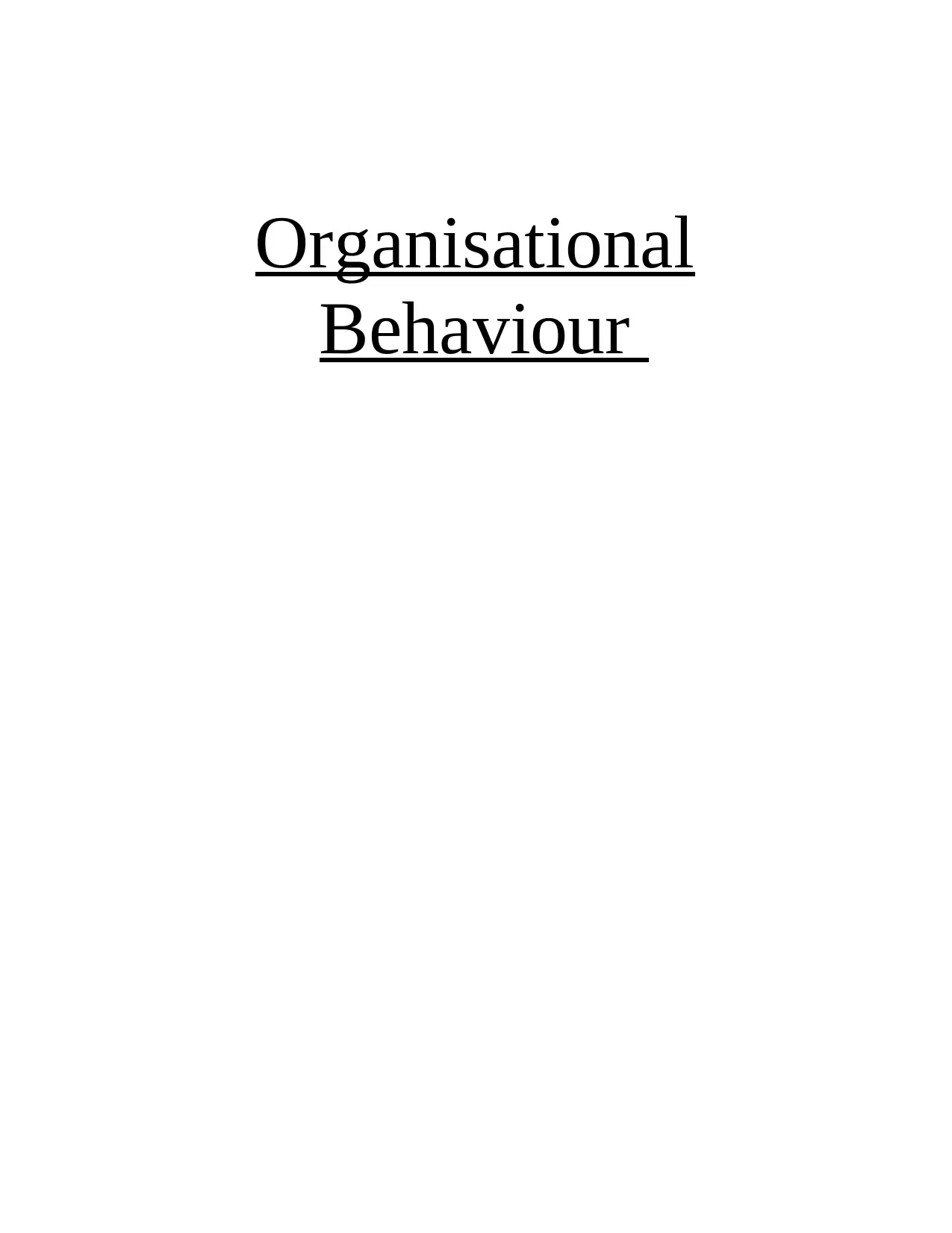
Organisational
Behaviour
Behaviour
Paraphrase This Document
Need a fresh take? Get an instant paraphrase of this document with our AI Paraphraser
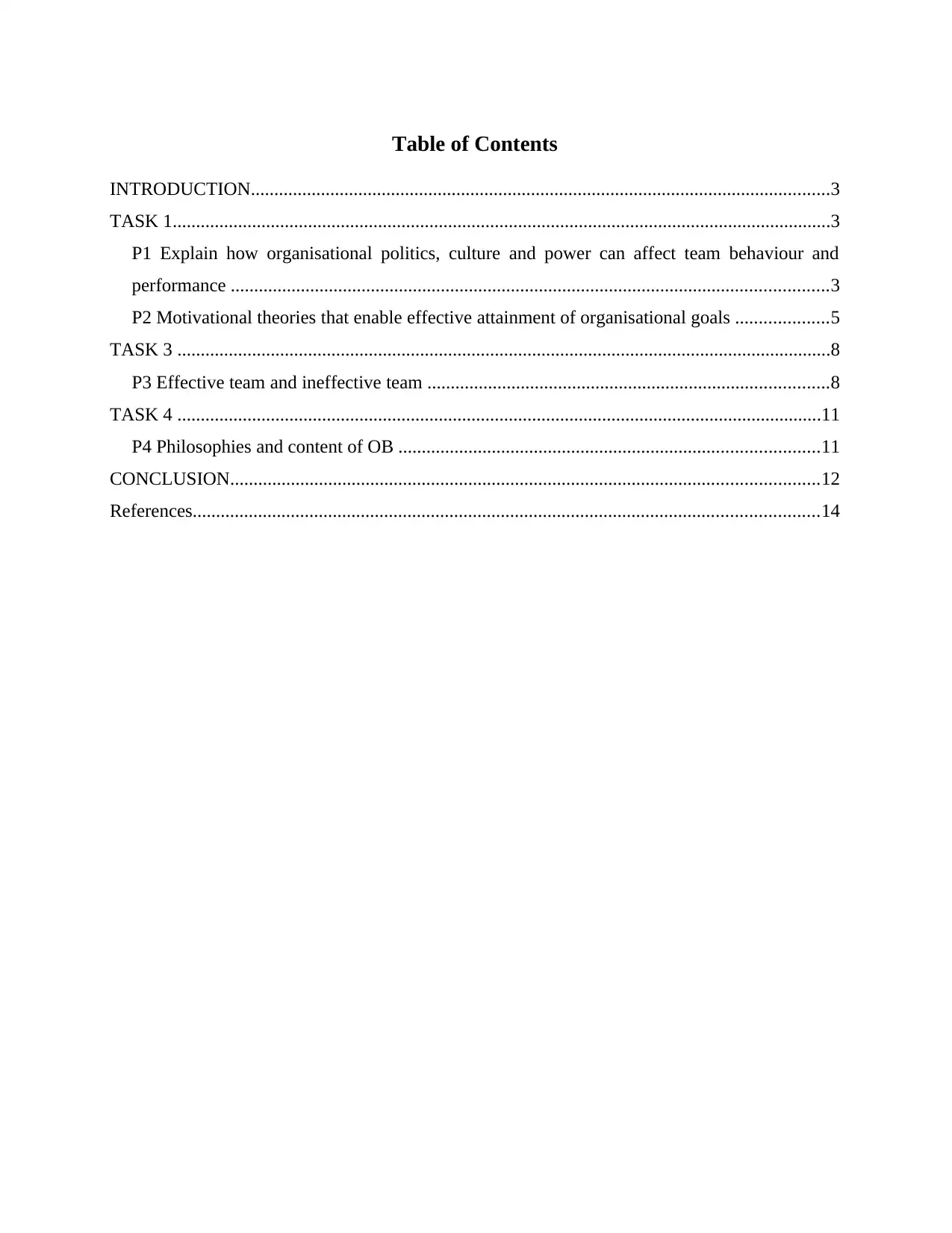
Table of Contents
INTRODUCTION............................................................................................................................3
TASK 1.............................................................................................................................................3
P1 Explain how organisational politics, culture and power can affect team behaviour and
performance ................................................................................................................................3
P2 Motivational theories that enable effective attainment of organisational goals ....................5
TASK 3 ............................................................................................................................................8
P3 Effective team and ineffective team ......................................................................................8
TASK 4 ..........................................................................................................................................11
P4 Philosophies and content of OB ..........................................................................................11
CONCLUSION..............................................................................................................................12
References......................................................................................................................................14
INTRODUCTION............................................................................................................................3
TASK 1.............................................................................................................................................3
P1 Explain how organisational politics, culture and power can affect team behaviour and
performance ................................................................................................................................3
P2 Motivational theories that enable effective attainment of organisational goals ....................5
TASK 3 ............................................................................................................................................8
P3 Effective team and ineffective team ......................................................................................8
TASK 4 ..........................................................................................................................................11
P4 Philosophies and content of OB ..........................................................................................11
CONCLUSION..............................................................................................................................12
References......................................................................................................................................14

INTRODUCTION
Organisational behaviour also known as organisational management is defined as the way
in which different individuals working within the company behave towards different workplace
situations. This is the academic study of people's behaviour. If an organisation has proper
knowledge about organisational behaviour, different problems and conflicts of workplace will
not arise. The field of OB is related to different topics such as job satisfaction, encouraging
leadership, promoting innovation and employee engagement. In the following report, company
considered is Primark. This is one of the flourished businesses of UK. This company offers
quality products at affordable price. The operations of this company are divided into different
sectors such as Hosiery, Underwear and Nightwear, Children wear, Men's wear and accessories.
This report will help in understanding the concept of organisational politics, culture and power
on performance of team (Alblas, Wijsman, and van Noort, 2019). This includes motivational
theories which an organisation adopts and philosophies and theories of OB.
TASK 1
P1 Explain how organisational politics, culture and power can affect team behaviour and
performance
OB is essential for managing and controlling the behaviour of employees working in the
company. Some factors present at workplace affect the organisational behaviour such as power,
politics and culture. Power is known as leadership by which higher executives control their
subordinates and workers. Culture is defined as value, belief and thoughts that are followed
within the company (Burrell, and Morgan, 2019). Politics is a term which is used as a negative
factor in workplaces. This includes benefiting the non productive employee just because he or
she is friendly with higher executives of the company. All the factors power, politics and culture
are discussed below -
Power
This is an essential strength which must be used by managers and leaders effectively for
managing and controlling business operations and functions appropriately. The top executives of
the company must use their power within organisation effectively. The managers and leaders of
Primark must use their power appropriately for managing business operations. The different
type of power used within Primark are mentioned below -
Organisational behaviour also known as organisational management is defined as the way
in which different individuals working within the company behave towards different workplace
situations. This is the academic study of people's behaviour. If an organisation has proper
knowledge about organisational behaviour, different problems and conflicts of workplace will
not arise. The field of OB is related to different topics such as job satisfaction, encouraging
leadership, promoting innovation and employee engagement. In the following report, company
considered is Primark. This is one of the flourished businesses of UK. This company offers
quality products at affordable price. The operations of this company are divided into different
sectors such as Hosiery, Underwear and Nightwear, Children wear, Men's wear and accessories.
This report will help in understanding the concept of organisational politics, culture and power
on performance of team (Alblas, Wijsman, and van Noort, 2019). This includes motivational
theories which an organisation adopts and philosophies and theories of OB.
TASK 1
P1 Explain how organisational politics, culture and power can affect team behaviour and
performance
OB is essential for managing and controlling the behaviour of employees working in the
company. Some factors present at workplace affect the organisational behaviour such as power,
politics and culture. Power is known as leadership by which higher executives control their
subordinates and workers. Culture is defined as value, belief and thoughts that are followed
within the company (Burrell, and Morgan, 2019). Politics is a term which is used as a negative
factor in workplaces. This includes benefiting the non productive employee just because he or
she is friendly with higher executives of the company. All the factors power, politics and culture
are discussed below -
Power
This is an essential strength which must be used by managers and leaders effectively for
managing and controlling business operations and functions appropriately. The top executives of
the company must use their power within organisation effectively. The managers and leaders of
Primark must use their power appropriately for managing business operations. The different
type of power used within Primark are mentioned below -
⊘ This is a preview!⊘
Do you want full access?
Subscribe today to unlock all pages.

Trusted by 1+ million students worldwide
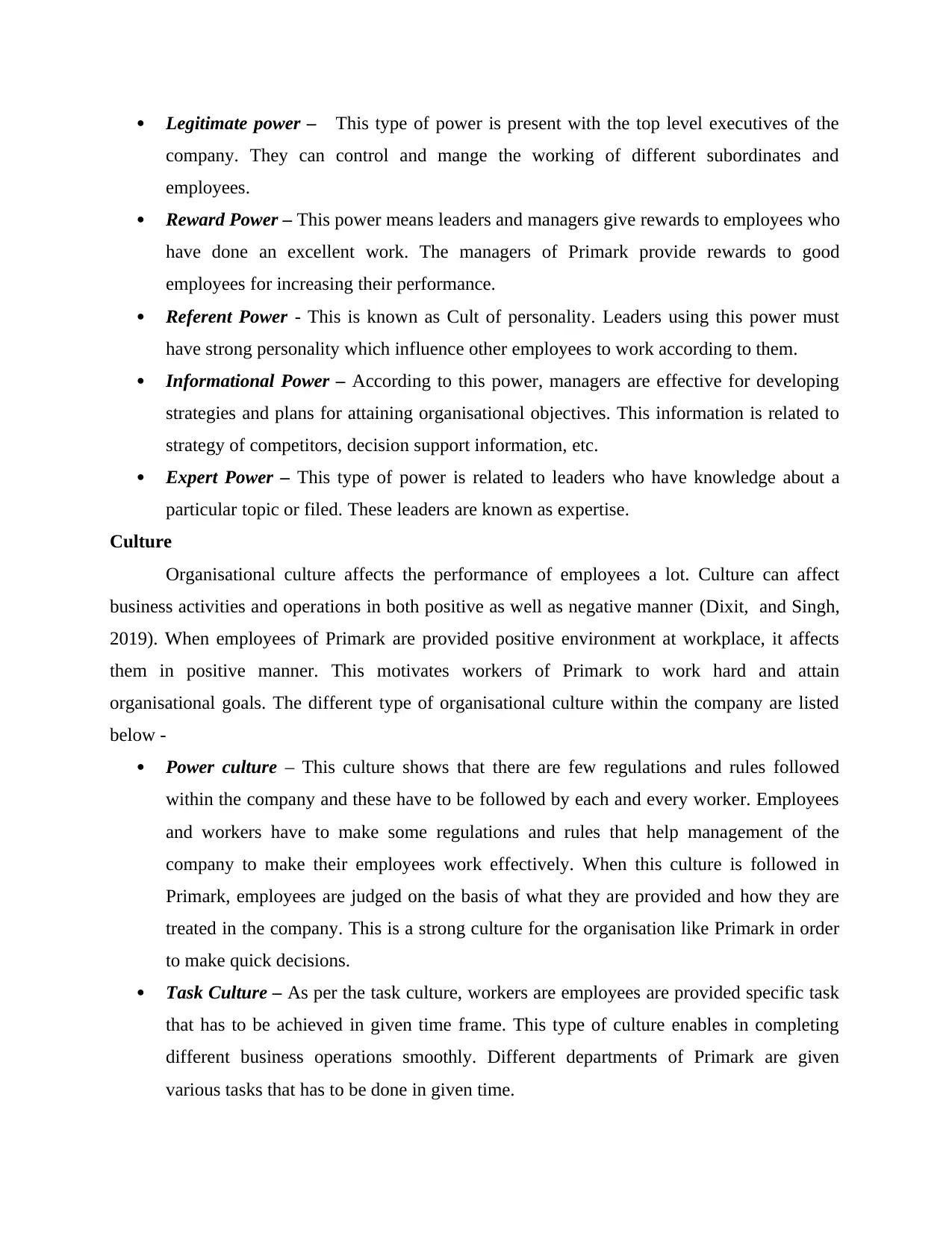
Legitimate power – This type of power is present with the top level executives of the
company. They can control and mange the working of different subordinates and
employees.
Reward Power – This power means leaders and managers give rewards to employees who
have done an excellent work. The managers of Primark provide rewards to good
employees for increasing their performance.
Referent Power - This is known as Cult of personality. Leaders using this power must
have strong personality which influence other employees to work according to them.
Informational Power – According to this power, managers are effective for developing
strategies and plans for attaining organisational objectives. This information is related to
strategy of competitors, decision support information, etc.
Expert Power – This type of power is related to leaders who have knowledge about a
particular topic or filed. These leaders are known as expertise.
Culture
Organisational culture affects the performance of employees a lot. Culture can affect
business activities and operations in both positive as well as negative manner (Dixit, and Singh,
2019). When employees of Primark are provided positive environment at workplace, it affects
them in positive manner. This motivates workers of Primark to work hard and attain
organisational goals. The different type of organisational culture within the company are listed
below -
Power culture – This culture shows that there are few regulations and rules followed
within the company and these have to be followed by each and every worker. Employees
and workers have to make some regulations and rules that help management of the
company to make their employees work effectively. When this culture is followed in
Primark, employees are judged on the basis of what they are provided and how they are
treated in the company. This is a strong culture for the organisation like Primark in order
to make quick decisions.
Task Culture – As per the task culture, workers are employees are provided specific task
that has to be achieved in given time frame. This type of culture enables in completing
different business operations smoothly. Different departments of Primark are given
various tasks that has to be done in given time.
company. They can control and mange the working of different subordinates and
employees.
Reward Power – This power means leaders and managers give rewards to employees who
have done an excellent work. The managers of Primark provide rewards to good
employees for increasing their performance.
Referent Power - This is known as Cult of personality. Leaders using this power must
have strong personality which influence other employees to work according to them.
Informational Power – According to this power, managers are effective for developing
strategies and plans for attaining organisational objectives. This information is related to
strategy of competitors, decision support information, etc.
Expert Power – This type of power is related to leaders who have knowledge about a
particular topic or filed. These leaders are known as expertise.
Culture
Organisational culture affects the performance of employees a lot. Culture can affect
business activities and operations in both positive as well as negative manner (Dixit, and Singh,
2019). When employees of Primark are provided positive environment at workplace, it affects
them in positive manner. This motivates workers of Primark to work hard and attain
organisational goals. The different type of organisational culture within the company are listed
below -
Power culture – This culture shows that there are few regulations and rules followed
within the company and these have to be followed by each and every worker. Employees
and workers have to make some regulations and rules that help management of the
company to make their employees work effectively. When this culture is followed in
Primark, employees are judged on the basis of what they are provided and how they are
treated in the company. This is a strong culture for the organisation like Primark in order
to make quick decisions.
Task Culture – As per the task culture, workers are employees are provided specific task
that has to be achieved in given time frame. This type of culture enables in completing
different business operations smoothly. Different departments of Primark are given
various tasks that has to be done in given time.
Paraphrase This Document
Need a fresh take? Get an instant paraphrase of this document with our AI Paraphraser

Person culture – In context of person culture, employees and workers of the company are
unique and every employee has it's own way of doing work. Primark ensures that those
employees who are skilled and experienced are hired so that they can work for the
company.
Role culture – According to this culture, there are strict rules and regulations that the
company has to follow. Leaders working in this type of culture know their roles and
responsibilities. They are generally bureaucratic leaders.
Politics
The workplace politics are defined as process and behaviour in individuals involving
authority and power. This is also termed as organisational politics and office politics.
Organisational politics are known as self serving behaviours that are used by workers for
increasing profitability of obtaining positive outcomes within the company (Habeeb, 2019).
Political landscape is defined as set of hierarchies which link political players together. This is
relationship between colleagues at a specified time. Manipulation is defined as any relationship
between one or more parties which include uses of of indirect means for achieving organisational
goals. There are various ways by which employees are affected if there is existence of
organisational politics within workplace. Some of these are mentioned below -
Productivity and performance are decreased – Workers and employees involved in
mischievous activities and tasks do not concentrate on their work. This declines the employee as
well as organisation performance.
Demotivation among workers – Workers and employees who are ill treated or made fun
of feel depressed and demotivated. This declines their efficiency of working.
P2 Motivational theories that enable effective attainment of organisational goals
Motivation is an important factor used within the companies for motivating their workers
and employees to achieve their goals in given time frame. There are various motivational theories
adopted within organisations for encouraging employees to achieve the desired goals in less time.
Performance of employees is directly linked to the level of their motivation. It is proven that
when employees are motivated then they work is efficient manner. In this way, performance of
both employee as well as organisation is enhanced (Hadi, Abdullah, and Atshan, 2019). There
are basically two types of motivational theories like content theory and process theory. In context
of Primark, these are described below-
unique and every employee has it's own way of doing work. Primark ensures that those
employees who are skilled and experienced are hired so that they can work for the
company.
Role culture – According to this culture, there are strict rules and regulations that the
company has to follow. Leaders working in this type of culture know their roles and
responsibilities. They are generally bureaucratic leaders.
Politics
The workplace politics are defined as process and behaviour in individuals involving
authority and power. This is also termed as organisational politics and office politics.
Organisational politics are known as self serving behaviours that are used by workers for
increasing profitability of obtaining positive outcomes within the company (Habeeb, 2019).
Political landscape is defined as set of hierarchies which link political players together. This is
relationship between colleagues at a specified time. Manipulation is defined as any relationship
between one or more parties which include uses of of indirect means for achieving organisational
goals. There are various ways by which employees are affected if there is existence of
organisational politics within workplace. Some of these are mentioned below -
Productivity and performance are decreased – Workers and employees involved in
mischievous activities and tasks do not concentrate on their work. This declines the employee as
well as organisation performance.
Demotivation among workers – Workers and employees who are ill treated or made fun
of feel depressed and demotivated. This declines their efficiency of working.
P2 Motivational theories that enable effective attainment of organisational goals
Motivation is an important factor used within the companies for motivating their workers
and employees to achieve their goals in given time frame. There are various motivational theories
adopted within organisations for encouraging employees to achieve the desired goals in less time.
Performance of employees is directly linked to the level of their motivation. It is proven that
when employees are motivated then they work is efficient manner. In this way, performance of
both employee as well as organisation is enhanced (Hadi, Abdullah, and Atshan, 2019). There
are basically two types of motivational theories like content theory and process theory. In context
of Primark, these are described below-
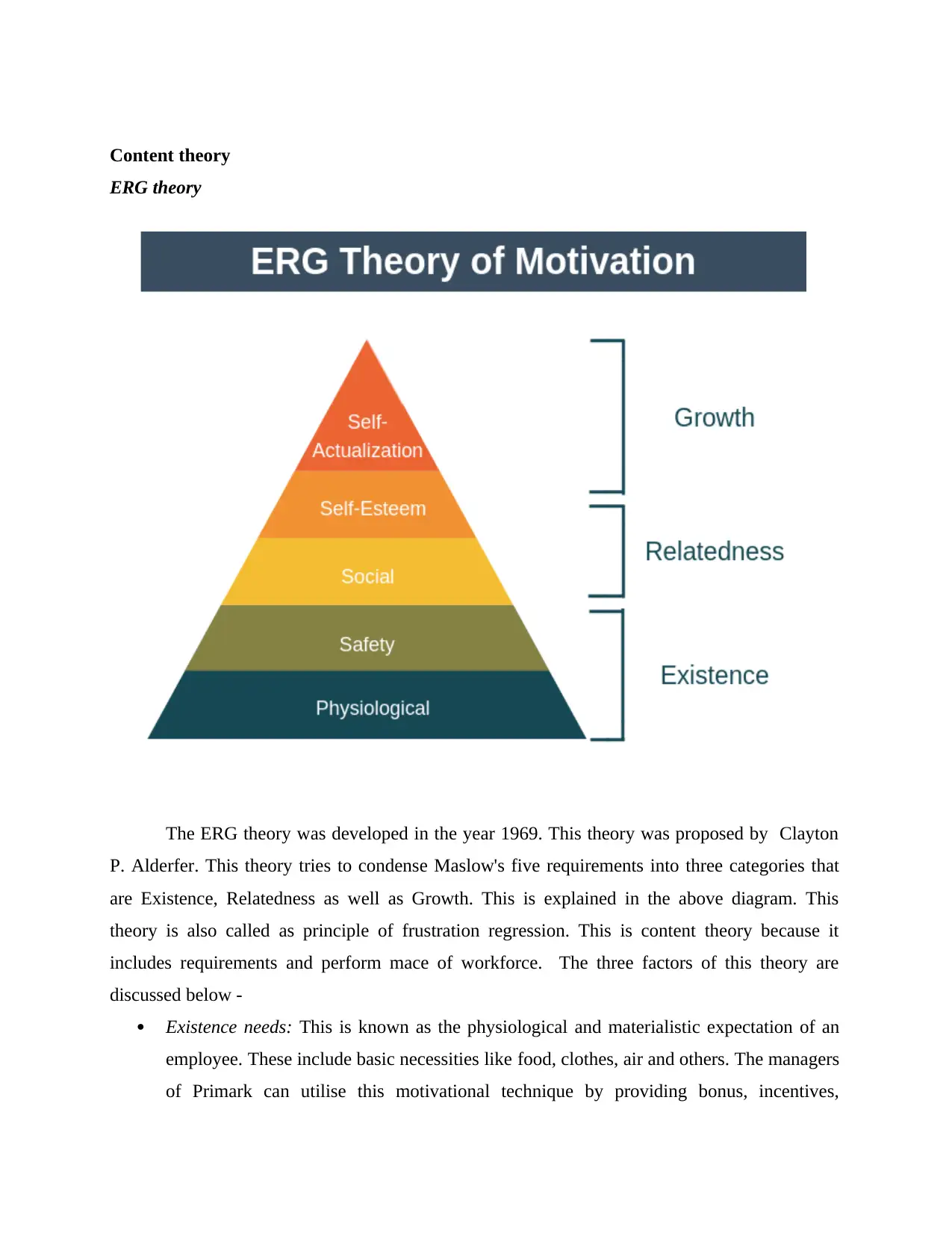
Content theory
ERG theory
The ERG theory was developed in the year 1969. This theory was proposed by Clayton
P. Alderfer. This theory tries to condense Maslow's five requirements into three categories that
are Existence, Relatedness as well as Growth. This is explained in the above diagram. This
theory is also called as principle of frustration regression. This is content theory because it
includes requirements and perform mace of workforce. The three factors of this theory are
discussed below -
Existence needs: This is known as the physiological and materialistic expectation of an
employee. These include basic necessities like food, clothes, air and others. The managers
of Primark can utilise this motivational technique by providing bonus, incentives,
ERG theory
The ERG theory was developed in the year 1969. This theory was proposed by Clayton
P. Alderfer. This theory tries to condense Maslow's five requirements into three categories that
are Existence, Relatedness as well as Growth. This is explained in the above diagram. This
theory is also called as principle of frustration regression. This is content theory because it
includes requirements and perform mace of workforce. The three factors of this theory are
discussed below -
Existence needs: This is known as the physiological and materialistic expectation of an
employee. These include basic necessities like food, clothes, air and others. The managers
of Primark can utilise this motivational technique by providing bonus, incentives,
⊘ This is a preview!⊘
Do you want full access?
Subscribe today to unlock all pages.

Trusted by 1+ million students worldwide

stipulation to the employees. When all requirements of employees are achieved then it is
easy for them to concentrate on work and achieve organisational objective and goal.
Relatedness needs: This step includes different requirements like social and external
esteem. Employees of Primark want to have good status and reputation. This can be
achieved by working collaboratively and developing good relations with with peers,
family and others. Primark managers can organise unofficial parties and get togethers so
that motivation of employees can be increased.
Growth needs: These are defined as needs and requirements that influence an individual
for enriching one's personality that is based on the needs of organisation. The managers of
Primark will provide training and development sessions for employees and workers. This
will motivate them to attain organisational goals and objectives. Such trainings leads to
increase innovative thinking of employees.
At work level, this is known as the ability of managers to know requirements and needs
of all employees for achieving their goals and objectives. The Primark leaders and managers are
concentrating on how to make employees achieve their targets in given time.
Process theory
Vroom's Expectancy theory
easy for them to concentrate on work and achieve organisational objective and goal.
Relatedness needs: This step includes different requirements like social and external
esteem. Employees of Primark want to have good status and reputation. This can be
achieved by working collaboratively and developing good relations with with peers,
family and others. Primark managers can organise unofficial parties and get togethers so
that motivation of employees can be increased.
Growth needs: These are defined as needs and requirements that influence an individual
for enriching one's personality that is based on the needs of organisation. The managers of
Primark will provide training and development sessions for employees and workers. This
will motivate them to attain organisational goals and objectives. Such trainings leads to
increase innovative thinking of employees.
At work level, this is known as the ability of managers to know requirements and needs
of all employees for achieving their goals and objectives. The Primark leaders and managers are
concentrating on how to make employees achieve their targets in given time.
Process theory
Vroom's Expectancy theory
Paraphrase This Document
Need a fresh take? Get an instant paraphrase of this document with our AI Paraphraser
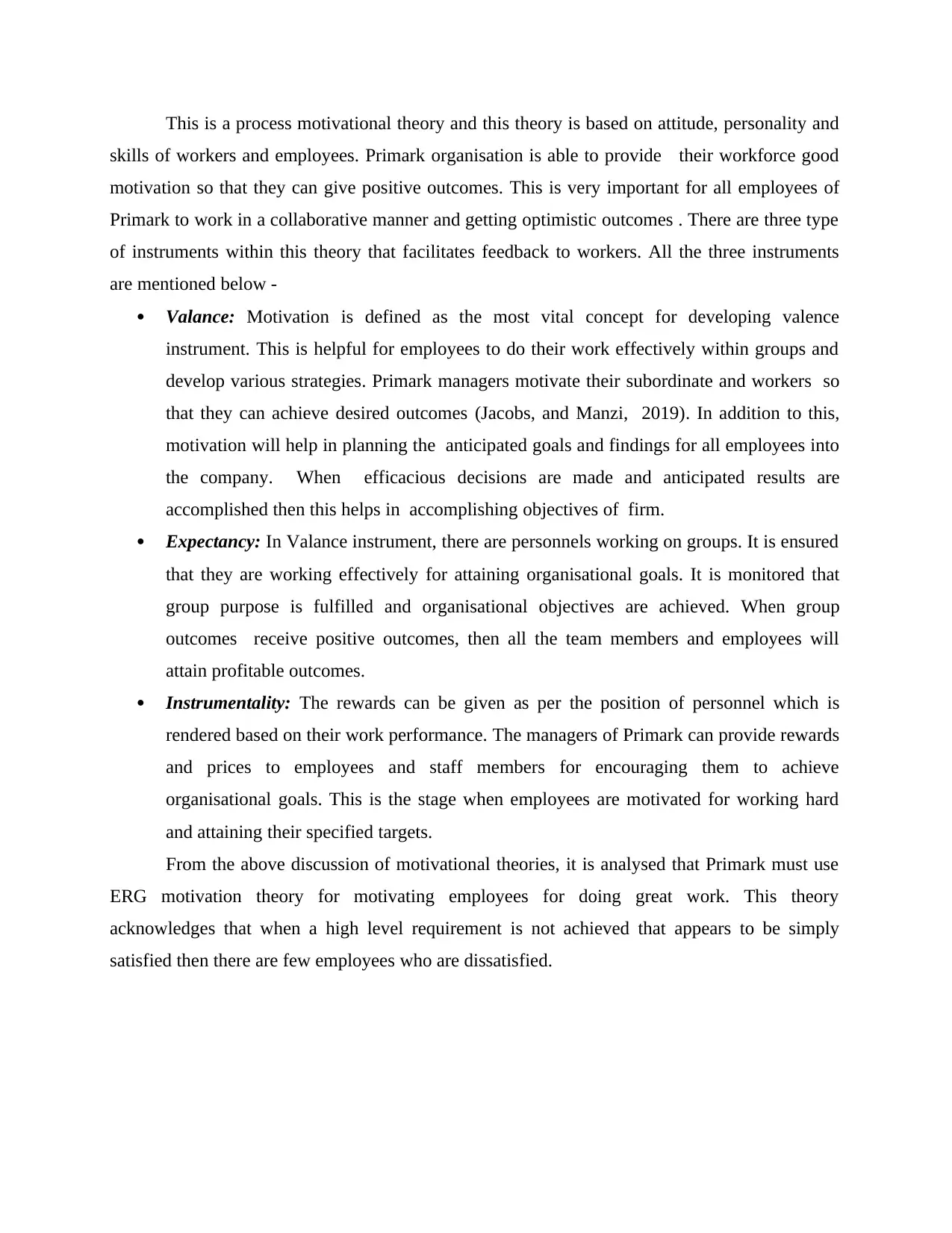
This is a process motivational theory and this theory is based on attitude, personality and
skills of workers and employees. Primark organisation is able to provide their workforce good
motivation so that they can give positive outcomes. This is very important for all employees of
Primark to work in a collaborative manner and getting optimistic outcomes . There are three type
of instruments within this theory that facilitates feedback to workers. All the three instruments
are mentioned below -
Valance: Motivation is defined as the most vital concept for developing valence
instrument. This is helpful for employees to do their work effectively within groups and
develop various strategies. Primark managers motivate their subordinate and workers so
that they can achieve desired outcomes (Jacobs, and Manzi, 2019). In addition to this,
motivation will help in planning the anticipated goals and findings for all employees into
the company. When efficacious decisions are made and anticipated results are
accomplished then this helps in accomplishing objectives of firm.
Expectancy: In Valance instrument, there are personnels working on groups. It is ensured
that they are working effectively for attaining organisational goals. It is monitored that
group purpose is fulfilled and organisational objectives are achieved. When group
outcomes receive positive outcomes, then all the team members and employees will
attain profitable outcomes.
Instrumentality: The rewards can be given as per the position of personnel which is
rendered based on their work performance. The managers of Primark can provide rewards
and prices to employees and staff members for encouraging them to achieve
organisational goals. This is the stage when employees are motivated for working hard
and attaining their specified targets.
From the above discussion of motivational theories, it is analysed that Primark must use
ERG motivation theory for motivating employees for doing great work. This theory
acknowledges that when a high level requirement is not achieved that appears to be simply
satisfied then there are few employees who are dissatisfied.
skills of workers and employees. Primark organisation is able to provide their workforce good
motivation so that they can give positive outcomes. This is very important for all employees of
Primark to work in a collaborative manner and getting optimistic outcomes . There are three type
of instruments within this theory that facilitates feedback to workers. All the three instruments
are mentioned below -
Valance: Motivation is defined as the most vital concept for developing valence
instrument. This is helpful for employees to do their work effectively within groups and
develop various strategies. Primark managers motivate their subordinate and workers so
that they can achieve desired outcomes (Jacobs, and Manzi, 2019). In addition to this,
motivation will help in planning the anticipated goals and findings for all employees into
the company. When efficacious decisions are made and anticipated results are
accomplished then this helps in accomplishing objectives of firm.
Expectancy: In Valance instrument, there are personnels working on groups. It is ensured
that they are working effectively for attaining organisational goals. It is monitored that
group purpose is fulfilled and organisational objectives are achieved. When group
outcomes receive positive outcomes, then all the team members and employees will
attain profitable outcomes.
Instrumentality: The rewards can be given as per the position of personnel which is
rendered based on their work performance. The managers of Primark can provide rewards
and prices to employees and staff members for encouraging them to achieve
organisational goals. This is the stage when employees are motivated for working hard
and attaining their specified targets.
From the above discussion of motivational theories, it is analysed that Primark must use
ERG motivation theory for motivating employees for doing great work. This theory
acknowledges that when a high level requirement is not achieved that appears to be simply
satisfied then there are few employees who are dissatisfied.

TASK 3
P3 Effective team and ineffective team
The presence of effective team within the organisation is important as it helps in
managing all business activities and achieving the organisational goals within specified time
frame (Kia, Halvorsen, and Bartram, 2019). Effective teams are those in which all team
members work collaboratively and achieve their targets within assigned time. On the other hand,
ineffective team is one in which team members do not work properly and they are not able to
achieve their goals in given time frame. The difference between effective and ineffective teams is
mentioned below -
Factors Effective teams Ineffective teams
Participation
All members participate with
full dedication and give their
efforts in all discussions.
All members do not show keen
interest in different discussions
that take place.
Underlying goals
The objective or aim is
understood by all team mates.
These members do not
understand the organisational
goals and aims.
Conflict resolution
If there is disagreement to
anything, then all team
members are involved in
discussion and majority wins.
Disagreements within
ineffective teams are not
treated effectively.
Decision making
Mostly all the decisions
developed by effective teams
are quick and good.
Decision making process is not
at all effective.
Leadership
The leader involves all team
mates while making decisions.
The leaders are not effective so
they are not able to manage
teams effectively.
P3 Effective team and ineffective team
The presence of effective team within the organisation is important as it helps in
managing all business activities and achieving the organisational goals within specified time
frame (Kia, Halvorsen, and Bartram, 2019). Effective teams are those in which all team
members work collaboratively and achieve their targets within assigned time. On the other hand,
ineffective team is one in which team members do not work properly and they are not able to
achieve their goals in given time frame. The difference between effective and ineffective teams is
mentioned below -
Factors Effective teams Ineffective teams
Participation
All members participate with
full dedication and give their
efforts in all discussions.
All members do not show keen
interest in different discussions
that take place.
Underlying goals
The objective or aim is
understood by all team mates.
These members do not
understand the organisational
goals and aims.
Conflict resolution
If there is disagreement to
anything, then all team
members are involved in
discussion and majority wins.
Disagreements within
ineffective teams are not
treated effectively.
Decision making
Mostly all the decisions
developed by effective teams
are quick and good.
Decision making process is not
at all effective.
Leadership
The leader involves all team
mates while making decisions.
The leaders are not effective so
they are not able to manage
teams effectively.
⊘ This is a preview!⊘
Do you want full access?
Subscribe today to unlock all pages.

Trusted by 1+ million students worldwide
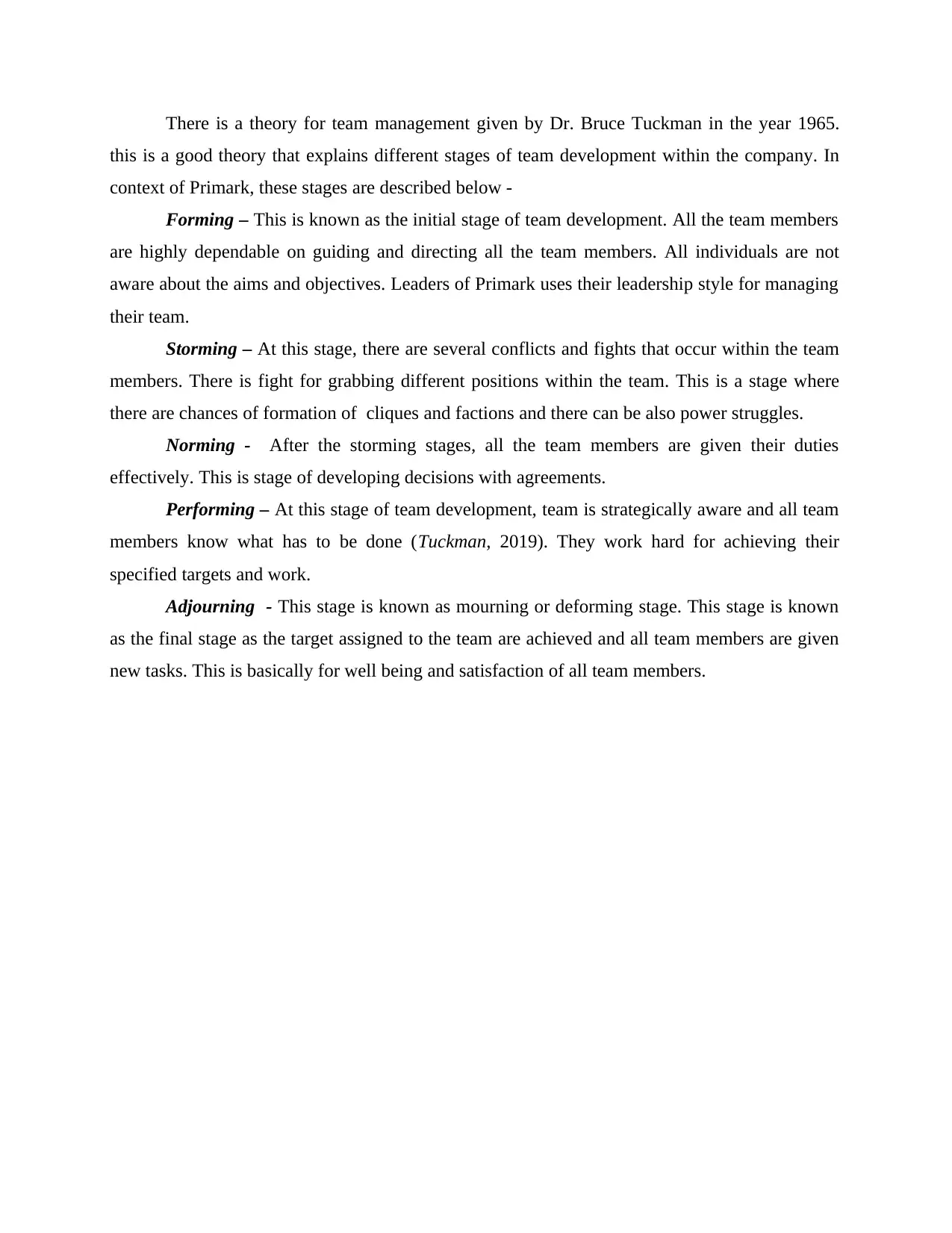
There is a theory for team management given by Dr. Bruce Tuckman in the year 1965.
this is a good theory that explains different stages of team development within the company. In
context of Primark, these stages are described below -
Forming – This is known as the initial stage of team development. All the team members
are highly dependable on guiding and directing all the team members. All individuals are not
aware about the aims and objectives. Leaders of Primark uses their leadership style for managing
their team.
Storming – At this stage, there are several conflicts and fights that occur within the team
members. There is fight for grabbing different positions within the team. This is a stage where
there are chances of formation of cliques and factions and there can be also power struggles.
Norming - After the storming stages, all the team members are given their duties
effectively. This is stage of developing decisions with agreements.
Performing – At this stage of team development, team is strategically aware and all team
members know what has to be done (Tuckman, 2019). They work hard for achieving their
specified targets and work.
Adjourning - This stage is known as mourning or deforming stage. This stage is known
as the final stage as the target assigned to the team are achieved and all team members are given
new tasks. This is basically for well being and satisfaction of all team members.
this is a good theory that explains different stages of team development within the company. In
context of Primark, these stages are described below -
Forming – This is known as the initial stage of team development. All the team members
are highly dependable on guiding and directing all the team members. All individuals are not
aware about the aims and objectives. Leaders of Primark uses their leadership style for managing
their team.
Storming – At this stage, there are several conflicts and fights that occur within the team
members. There is fight for grabbing different positions within the team. This is a stage where
there are chances of formation of cliques and factions and there can be also power struggles.
Norming - After the storming stages, all the team members are given their duties
effectively. This is stage of developing decisions with agreements.
Performing – At this stage of team development, team is strategically aware and all team
members know what has to be done (Tuckman, 2019). They work hard for achieving their
specified targets and work.
Adjourning - This stage is known as mourning or deforming stage. This stage is known
as the final stage as the target assigned to the team are achieved and all team members are given
new tasks. This is basically for well being and satisfaction of all team members.
Paraphrase This Document
Need a fresh take? Get an instant paraphrase of this document with our AI Paraphraser
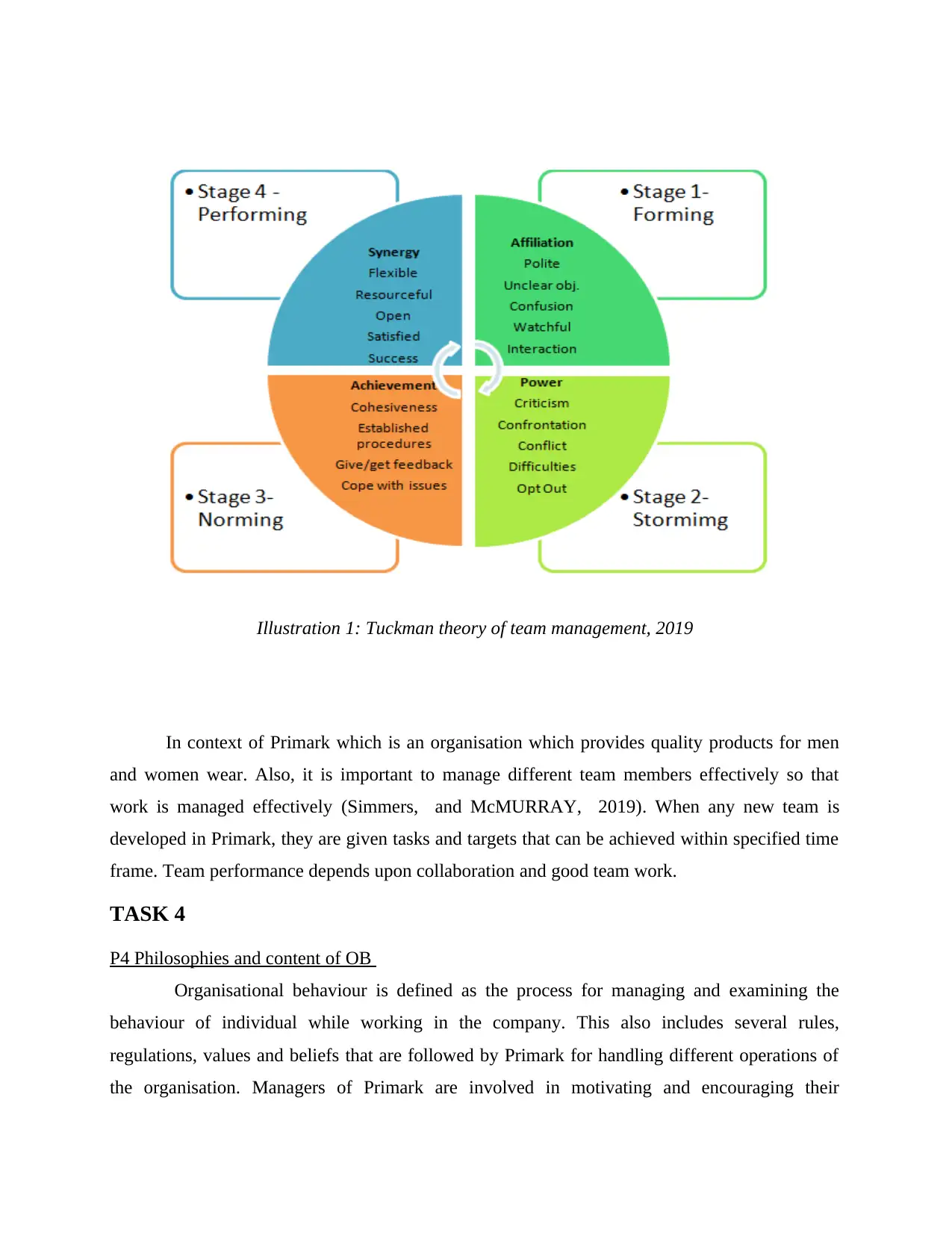
In context of Primark which is an organisation which provides quality products for men
and women wear. Also, it is important to manage different team members effectively so that
work is managed effectively (Simmers, and McMURRAY, 2019). When any new team is
developed in Primark, they are given tasks and targets that can be achieved within specified time
frame. Team performance depends upon collaboration and good team work.
TASK 4
P4 Philosophies and content of OB
Organisational behaviour is defined as the process for managing and examining the
behaviour of individual while working in the company. This also includes several rules,
regulations, values and beliefs that are followed by Primark for handling different operations of
the organisation. Managers of Primark are involved in motivating and encouraging their
Illustration 1: Tuckman theory of team management, 2019
and women wear. Also, it is important to manage different team members effectively so that
work is managed effectively (Simmers, and McMURRAY, 2019). When any new team is
developed in Primark, they are given tasks and targets that can be achieved within specified time
frame. Team performance depends upon collaboration and good team work.
TASK 4
P4 Philosophies and content of OB
Organisational behaviour is defined as the process for managing and examining the
behaviour of individual while working in the company. This also includes several rules,
regulations, values and beliefs that are followed by Primark for handling different operations of
the organisation. Managers of Primark are involved in motivating and encouraging their
Illustration 1: Tuckman theory of team management, 2019

employees to work hard. There are few concepts and theories of organisational behaviour. These
are mentioned below -
Business Condition: In context of Primark, this organisation deals in the garment selling
and thus it is using new technologies and techniques for functioning. There is no proper
management among employees related to the technological advancement of company. Thus, the
managers of Primark have decided to provide information to their workers and employees about
this new technique. They have to motivate workers for attaining organisational goals and
objectives. To deal with the conditions in an impressive manner, the manager applies Path Goal
Theory which is discussed in detail below:
Path Goal Theory
The main objective of Path goal theory is to focus on examining various styles of
leadership that can help in attaining organisational objectives. Primark is an organisation which
had to motivate it's employees for working hard and increasing the efficiency of organisation's
performance. Employee motivation leads to employee satisfaction and employee engagement.
This helps in gaining profits and money by the company.
Categorization of Path Goal Theory
Employee Characteristics: The Primark managers and leaders enhance knowledge about
demands and needs of employees so that they are motivated. This is helpful for companies to
motivate their employees on regular basis. It is helpful in making them work effectively towards
organisational goals.
Environment and Task attributes: According to this factor, managers and leaders of
Primark focus on various problems faced by employees while working in the company. The
managers and leaders of Primark have to focus on various areas of the company. Different higher
authority executives are involved in providing positive environment to the workers. This is
helpful in increasing the performance and productivity of the company.
Leadership Behaviour: According to the stage of path goal theory it is concluded that
managers and leaders of Primark are adopting the most effective leadership style for managing
and handling business scenarios. The main impact of this is on the performance of employees and
workforce (Tjahjono, Fachrunnisa, and Palupi, 2019). The main objective of all leaders and
managers is to handle and manage different employees by motivating them enough to attain their
goals appropriately.
are mentioned below -
Business Condition: In context of Primark, this organisation deals in the garment selling
and thus it is using new technologies and techniques for functioning. There is no proper
management among employees related to the technological advancement of company. Thus, the
managers of Primark have decided to provide information to their workers and employees about
this new technique. They have to motivate workers for attaining organisational goals and
objectives. To deal with the conditions in an impressive manner, the manager applies Path Goal
Theory which is discussed in detail below:
Path Goal Theory
The main objective of Path goal theory is to focus on examining various styles of
leadership that can help in attaining organisational objectives. Primark is an organisation which
had to motivate it's employees for working hard and increasing the efficiency of organisation's
performance. Employee motivation leads to employee satisfaction and employee engagement.
This helps in gaining profits and money by the company.
Categorization of Path Goal Theory
Employee Characteristics: The Primark managers and leaders enhance knowledge about
demands and needs of employees so that they are motivated. This is helpful for companies to
motivate their employees on regular basis. It is helpful in making them work effectively towards
organisational goals.
Environment and Task attributes: According to this factor, managers and leaders of
Primark focus on various problems faced by employees while working in the company. The
managers and leaders of Primark have to focus on various areas of the company. Different higher
authority executives are involved in providing positive environment to the workers. This is
helpful in increasing the performance and productivity of the company.
Leadership Behaviour: According to the stage of path goal theory it is concluded that
managers and leaders of Primark are adopting the most effective leadership style for managing
and handling business scenarios. The main impact of this is on the performance of employees and
workforce (Tjahjono, Fachrunnisa, and Palupi, 2019). The main objective of all leaders and
managers is to handle and manage different employees by motivating them enough to attain their
goals appropriately.
⊘ This is a preview!⊘
Do you want full access?
Subscribe today to unlock all pages.

Trusted by 1+ million students worldwide
1 out of 14
Related Documents
Your All-in-One AI-Powered Toolkit for Academic Success.
+13062052269
info@desklib.com
Available 24*7 on WhatsApp / Email
![[object Object]](/_next/static/media/star-bottom.7253800d.svg)
Unlock your academic potential
Copyright © 2020–2025 A2Z Services. All Rights Reserved. Developed and managed by ZUCOL.





